Improve Your Quality Of Life Through Robotic-Assisted Surgery
Robotics in Surgery
The Benefits of Robotics in Vaginal Suspension Surgery
Justo Maqueira, Jr, MD
December 13, 2024
Vaginal suspension surgery is a critical procedure for women suffering from pelvic organ prolapse (POP) and other related conditions. Traditionally performed through open surgery or laparoscopically, these procedures can be challenging due to the complexity of the female anatomy and the intricacies involved in restoring pelvic support. However, the advent of robotic-assisted surgery has revolutionized this field, offering numerous benefits that enhance patient outcomes and surgical precision.
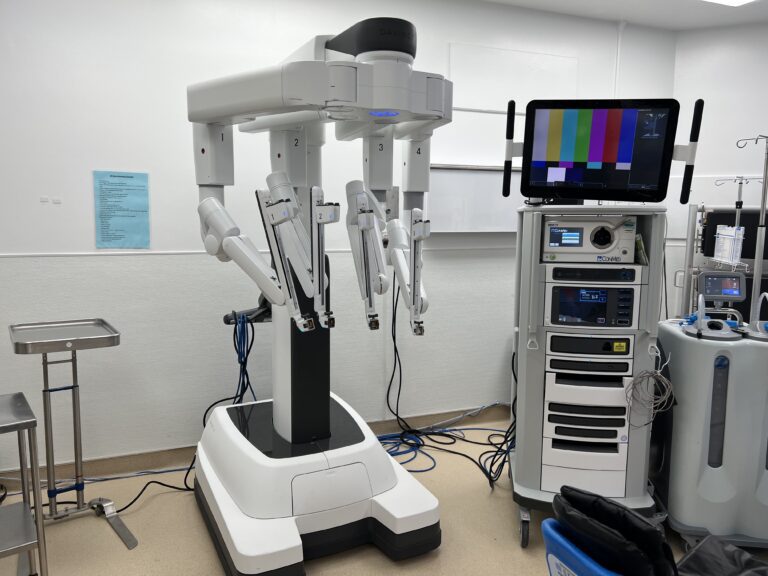
1. Enhanced Precision and Control
One of the most significant advantages of robotic systems in vaginal suspension surgery is the enhanced precision they provide. Robotic surgical instruments offer a greater range of motion and dexterity compared to traditional laparoscopic tools. Surgeons can perform intricate maneuvers with greater accuracy, which is particularly important in delicate areas such as the pelvic region. This precision helps minimize tissue trauma, leading to better preservation of surrounding structures.
2. Improved Visualization
Robotic systems are equipped with high-definition 3D cameras that provide surgeons with a magnified view of the surgical field. This improved visualization allows for better identification of anatomical landmarks and pathology, enabling more effective and targeted interventions. The enhanced depth perception afforded by 3D imaging is critical in complex surgeries, where even minor miscalculations can lead to complications.
3. Reduced Recovery Time
Patients undergoing robotic-assisted vaginal suspension surgery often experience shorter recovery times compared to those who undergo traditional open surgery. The minimally invasive nature of robotic procedures typically results in less postoperative pain, reduced scarring, and a lower risk of complications such as infections. Many patients can return to their daily activities more quickly, which is a significant benefit for those balancing work and family responsibilities.
4. Lower Risk of Complications
Robotic-assisted surgery has been associated with a lower risk of complications, including bleeding and infection. The precision of robotic instruments allows for more controlled dissection and suturing, which can minimize damage to surrounding tissues and blood vessels. Additionally, the minimally invasive approach reduces the likelihood of postoperative complications, contributing to overall patient safety.
5. Greater Surgeon Ergonomics
Robotic systems are designed to enhance the surgeon’s working environment. The ergonomic design of the robotic console allows surgeons to operate in a comfortable position, reducing fatigue during lengthy procedures. This improved ergonomics can lead to better focus and performance, ultimately benefiting patient outcomes.
6. Customization and Adaptability
Robotic surgical systems offer a range of instruments and tools that can be tailored to the specific needs of each patient and procedure. Surgeons can select the most appropriate instruments for the task at hand, allowing for customized approaches that enhance the effectiveness of the surgery. This adaptability is particularly beneficial in complex cases where standard techniques may not suffice.
7. Patient Satisfaction
The combination of reduced recovery times, lower complication rates, and improved surgical outcomes contributes to higher levels of patient satisfaction. Many women report significant improvements in their quality of life following robotic-assisted vaginal suspension surgery, experiencing relief from symptoms of prolapse and a return to normal activities.
Conclusion
The integration of robotics into vaginal suspension surgery represents a significant advancement in the field of gynecological surgery. With enhanced precision, improved visualization, reduced recovery times, and lower complication rates, robotic-assisted techniques are transforming the way these procedures are performed. As technology continues to evolve, the potential for further improvements in patient care and surgical outcomes will only increase, making robotics an invaluable tool in modern medicine.
Robotics in Surgery
Benefits of a Robotically-Assisted Total Knee Arthroplasty
Kaitlyn Davis PA-C
July 8, 2024
The robotics in medicine landscape is ever improving and evolving, and with that, it is easy to see how a robotically assisted total knee replacement (TKA) has substantial benefits to the patient over a standard total knee arthroplasty. Studies show improvements in patient satisfaction post-operatively, improved short term recovery and implant survivorship.
In a prospective cohort study by Kayani et al., they found that patients who underwent a robotically assisted total knee replacement, compared to patients who had a standard total knee arthroplasty, had decreased postoperative pain. They also had decreased anesthesia requirements and improved hemoglobin levels post-op (less blood loss in surgery) (Kayani et al., 2018). The decreased blood loss and decreased pain levels is also believed to be lower in patients with a robotic TKA, due to the robot’s ability to help reduce soft tissue injuries during the surgery. The decreased pain level of patients, also assists them to more confidently have these procedures done in an outpatient setting, meaning the patient is able to go home the same day as surgery.
The benefits to the patient’s short-term recovery, are also substantial. Studies show that patients with a robotic TKA, have less physical therapy sessions overall (Kayani et al. 2018). This decreases the total cost of post-op care for the patient. A large focus of physical therapy after a total knee replacement is regaining of range of motion and ability to walk unassisted. In the early/acute phase, patients who had a total knee that was robotically assisted, experienced improved range of motion (St Mart & Goh, 2021). Knee range of motion is measured at every physical therapy session and office visit; the robotic TKA patients were able to preform a straight leg raise sooner and had superior knee flexion (bending the knee) by the time they left the hospital (Kayani et al., 2018).
One of the largest driving factors for the development of the robotically assisted total knee replacement was to help improve implant survivorship (how long a total knee will last a patient). Implant survivorship is determined by the implant’s ability to bear the load and demand of the patient’s body. This is dependent on the implant’s mechanical alignment with the leg and the position and angle of the implant regarding how “tight” or “loose” the soft tissues are throughout the knee (St Mart & Goh, 2021). The robot can assist the surgeon in making cuts on the bone to allow incredibly precise placement of the implant, down to the millimeter. This precision best helps anatomically align the patient’s knee and distribute the load on the weight bearing implant. When these things are done, it decreases the risk of loosening of the components of the knee replacement and of early wear of the materials. As researchers St Mart and Guy put it, “Robotic systems were therefore developed to increase accuracy in implant sizing, component positioning and bone preparation to further reduce the risk of outliers and hopefully improve clinical outcome and long-term survivorship.”
Currently the long-term patient satisfaction and function are identical for knee replacements with and without the robot. However, as technology advances, we hope to continue to find more patient outcome benefits for a robotically assisted knee replacement. Improving the patient’s pain and returning them efficiently to the activities they love, is at the forefront of what drives the surgeons who utilize the robotically assisted knee replacements.
References:
Kayani, B., et al. “Robotic-Arm Assisted Total Knee Arthroplasty Is Associated with Improved Early Functional Recovery and Reduced Time to Hospital Discharge Compared with Conventional Jig-Based Total Knee Arthroplasty.” The Bone & Joint Journal, vol. 100-B, no. 7, July 2018, pp. 930–937, https://doi.org/10.1302/0301-620x.100b7.bjj-2017-1449.r1.
St Mart, J.-P., & Goh, E. L. (2021). The current state of robotics in total knee arthroplasty. EFORT Open Reviews, 6(4), 270-279. https://doi.org/10.1302/2058-52416.200052
Robotics in Surgery
Go Home the Same Day after a Robotic-Assisted Knee Replacement
Chad Mitchell, MD, FAAOS
November 14, 2023
Is it possible to have a robotic-assisted knee replacement and go home on the same day? Today’s advancements in technology, post-operative pain management, and blood loss management make it easy to avoid admission to the hospital and go home on the same day as the surgery. Not only are robotic-assisted knee replacement patients going home from the hospital on the same day, but many are now having the same surgery in surgery centers. That’s right. Many patients are avoiding the hospital altogether and having it performed in surgery centers. It is amazing to watch patients safely walk out of the recovery room and get into their car within a few hours of their knee surgery.
There are various protocols for making it possible for a patient to go home the same day after a knee replacement surgery, but these protocols all have the same basic concepts. These basic concepts include: minimizing blood loss, outpatient DVT (Deep Venous Thrombosis) prophylaxis, controlling pain while maximizing alertness, antibiotic prophylaxis, immediate range of motion of the operative knee, early safe ambulation, and outpatient physical therapy.
During surgery, tranexamic acid (TXA) is used to effectively minimize the risk of a blood transfusion after a knee replacement. This medication is usually administered intravenously or locally within the incision. It works by blocking the breakdown of clots within the incision, but it has not been associated with an increased risk of the bad clots known as deep venous thrombosis (DVT). Also, TXA significantly lessens post-operative bleeding complications which can complicate a patient’s knee motion following the procedure. In other words, TXA helps make early range of motion of the knee and early ambulation possible following surgery by preventing bleeding complications. TXA also has almost eliminated the possibility of a post-operative transfusion, so patient’s can safely go home the same day without worries of major bleeding.
Outpatient DVT prophylaxis has changed in recent years also. Baby aspirin (81 mg) taken two times a day has been effective DVT prophylaxis in joint replacement patients. This is an oral medication that is much less likely to cause bleeding than some of the other anticoagulants that are available. It is an easy to acquire over-the-counter medication.
One of the more significant medical advances allowing patients to go home the same day from a knee replacement is the outpatient post-operative pain management. A patient’s pain has to be managed in such a way as to allow the patient to be very alert following surgery. Nerve blocks before or after the surgery help with controlling pain without affecting alertness. Also, outpatient non-narcotic pain medications are a priority to help the patient use less narcotics. Narcotic medications are notorious for making patients drowsy and less alert, so many protocols have the patient use the non-narcotic pain medications first, and use the narcotics sparingly for breakthrough pain. If the patient is comfortable and alert in the recovery room, then the patient will be able to ambulate with a walker and go home safely.
Robotics is also helping transform same day knee replacement surgery. The increased precision and alignment of the components of a robotic-assisted knee replacement allow better range of motion of a patient’s knee. Patients are able to go home on the same day and are finding it easier to maintain good range of motion in the days immediately following the knee replacement.
Outpatient physical therapy is usually prescribed to help patient’s maintain their knee motion during the healing phase when scarring can occur. Also, patient’s that have possible increased infection risks from diabetes and smoking can go home on oral antibiotics, in addition to the intravenous antibiotics given at the time of surgery.
In summary, patients are going home the same day from robotic-assisted knee replacements given many advancements in surgical and post-surgical care. Talk to your surgeon about this option if you are considering a knee replacement.
Robotics in Surgery
The Benefits of Robotic Surgery in Gynecology
Justo Maqueira, Jr, MD
October 3, 2023
Robotic surgery in gynecology offers several benefits that make it a valuable tool for surgeons and patients alike.
Firstly, robotic surgery allows for greater precision and control during procedures. The robotic system enhances a surgeon’s dexterity by translating their hand movements into precise movements of the robotic arms, resulting in more precise incisions and sutures. This can lead to reduced tissue damage, less blood loss, and faster recovery times for patients.
Secondly, robotic surgery provides enhanced visualization capabilities. The robotic system offers high-definition 3D imaging, which allows surgeons to see anatomical structures with greater clarity and detail. This enables them to navigate complex and delicate gynecological anatomy more easily and accurately.

Justo Maqueira, Jr, MD is a board-certified gynecologist in Panama City, Florida. He specializes in robotic-assisted gynecologic surgery.
Furthermore, robotic surgery enables minimally invasive procedures. The robotic arms are small and can be inserted through tiny incisions, reducing the need for larger, more invasive incisions. The smaller incisions result in less pain, reduced scarring, and faster healing for patients.
In addition, robotic surgery allows for better access to hard-to-reach areas. The flexibility and range of motion of the robotic arms enable surgeons to maneuver around obstructions and access difficult-to-reach areas, improving the surgeon’s ability to perform detailed procedures.
Lastly, robotic surgery offers the potential for remote surgery. With advances in technology, it is becoming possible for surgeons to perform procedures remotely using robotic systems. This can be particularly beneficial in rural or underserved areas, where access to highly skilled surgeons may be limited.
Overall, the benefits of robotic surgery in gynecology include improved precision, enhanced visualization, minimally invasive procedures, better access to hard-to-reach areas, and the potential for remote surgery. These benefits ultimately contribute to better patient outcomes, shorter hospital stays, and faster recovery times.
Robotics in Surgery
Revision Knee Replacement Using Robotics
Chad Mitchell, MD, FAAOS
August 3, 2023
The emerging robotic technology in orthopedic surgery is quickly advancing, especially for partial and total knee replacements. The computer mapping technology combined with the robotic-assistance makes a great combination for precision cuts and joint alignment. Patients are seeing immediate ambulation and improved early knee range of motion following these surgeries.
The computer navigation and robotic-assistance surgeries are great for an arthritic knee, but can it help someone who may be having a problem with their previous knee replacement and need to have it revised? The need for total knee replacement revision includes those components that are loose, unstable, or infected.
Orthopedic knee replacement surgeons are using the computer navigation technology to maximize range of motion and stability outcomes following the revision surgery. Traditionally, revision total knee arthroplasties have significantly less patient satisfaction which is thought to be due to increased scarring, bone loss, joint line elevation, difficulty visualizing the proper knee alignment, and decreased range of motion. Revision knee replacements can have good results, but these revisions tend to have significantly lower range of motion and patient satisfaction scores.
To optimize knee function following a revision surgery, orthopedic surgeons are using computer navigation for mapping out the problem knee including the components. Also, the anatomic joint line can be recreated virtually, so that the revision knee surgery restores the proper joint line. A problem like an elevated joint line can lead to poor patient outcomes.* After mapping out the knee, the problem components are removed and the underlying bone defects are mapped into the computer system. The surgeon can then use the mapping data to tell the robotic drill where to make the precise cuts that will allow the new revision knee components to function with good range of motion, stability, and proper joint line height. All of this is an attempt to get a similar outcome to an original or primary knee replacement.
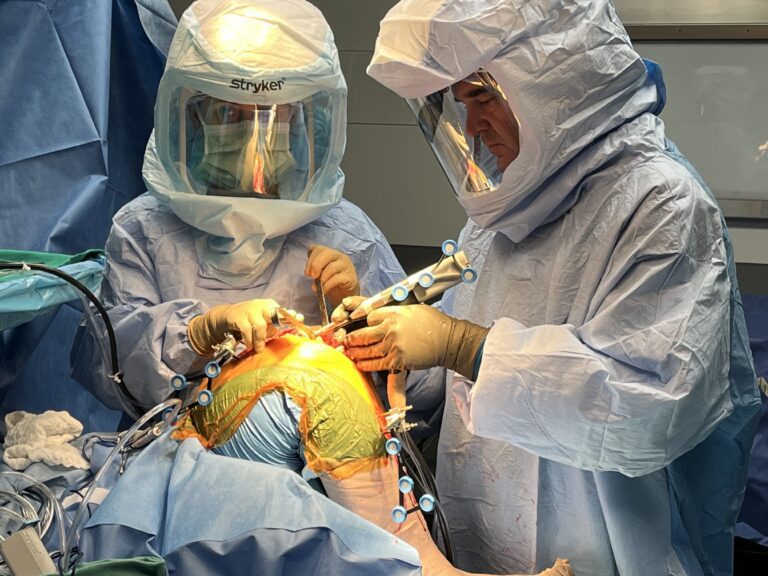
A robotic drill is used to mill the computer generated cuts that give the best implant position with respect to range of motion and stability of the knee. Notice the reflectors that give the computer robotic system points of reference to make the precision cuts. This robotic-assisted revision knee arthroplasty usually preserves more bone with a better surface fit of the components and less use of additional metal components.
Orthopedic surgeons who use robotic-assistance for revision knee replacements are anecdotally reporting that they are using less revision knee component parts and removing much less bone during the procedure. For patients, this translates into more stable components, better alignment and better range of motion of their revision total knee replacement. Some of these patients are also able to go home on the same day of surgery.
In my opinion, a robotic-assisted knee replacement revision with computer navigation is an excellent option for obtaining a precision-aligned knee after complications with a primary knee replacement. In my experience, these patient’s recover faster and some can go home from the surgery same day. As an orthopedic surgeon, it is encouraging to see the improved results of the robotic-assisted revision knee replacements over the previous methods used. Robotics certainly has a place in improving the healthcare of patients.
References:
[*] Buller LT, Metzger CM, Deckard ER, Meneghini RM. The Effect of Joint Line Elevation of Patient-Reported Outcomes After Contemporary Revision Total Knee Arthroplasty. The Journal of Arthroplasty. 2022;37;1146-1152.
Robotics in Surgery
Is Artificial Intelligence (AI) used during a Robotic Knee Replacement?
Chad Mitchell, MD, FAAOS
June 2023
Artificial intelligence (AI) has notoriously grabbed the headlines recently over concerns that it could result in unintended harm to humanity. Cyberattacks, autonomous weapons, misinformation campaigns, and loss of human autonomy are all valid concerns in a world of AI that can contradict our human or moral values. From a medical prospective, AI could help find cures for diseases and make surgeries more effective by lowering the risks for complications, but there is also concern that it has the potential to cause unintended medical complications.
Currently, partial and total knee replacement surgery is being transformed by the use of computer navigation and robotic-assistance systems. Early results suggest that patients are seeing the benefits of this technology with improved range of motion and precision alignment of their implants. Despite these benefits to patients, there is concern about possible unintended consequences from the technology. Many patients are concerned about how the technology is used and if their surgeon has full control over the system. These types of discussions usually lead to the question: is artificial intelligence used during a robotic knee replacement?
The answer to this question is yes. AI is used to help predict the best alignment of the knee replacement implants using the patient’s knee range of motion and stability data obtained at the time of surgery. This alignment prediction helps the surgeon fine tune your implants to give you the best custom result possible; however, the AI used in the robotic knee replacement systems have defined limits, and the surgeon has the final input into positioning your knee implants.
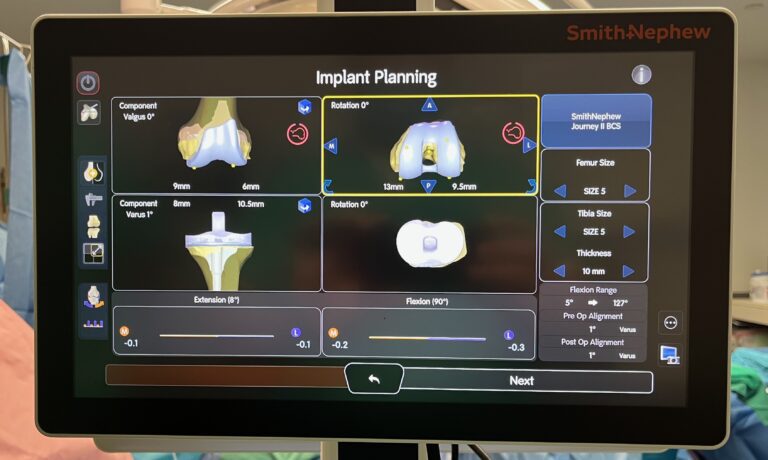
Artificial Intelligence (AI) is part of the computer robotic system used to perform partial and total knee replacement surgeries. This is an actual screen shot during a robotic surgery, and it shows the information available to the surgeon. The surgeon is able to fine-tune the implant placement while the AI keeps up with the predicted changes in stability and range of motion that would result from the surgeon's changes. This is done before a bone cut is made for the implants.
With over 25 years experience performing knee replacement surgeries and 2.5 years experience performing robotic knee replacements, It is my opinion that these robotic systems are safe for patients, and I have not experienced any incidences of malfunction of the AI during surgery. Rest assured, surgeons have the ability to abort the computer navigation and robotic assistance at any time during the procedure and finish the knee replacement manually, if needed. Patients can also be assured that these robotic systems have gone through a rigorous approval process both with the designers and with the Food and Drug Administration (FDA) before being released for use in the general population. Patient safety and good outcomes are the focus of these advanced computer and robotic systems.
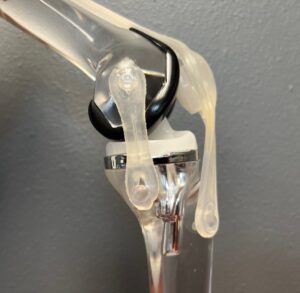
Model showing the components of a total knee replacement (total knee arthroplasty).
Although there are valid concerns about the future impact of AI on humanity, its current use in robotic knee replacements is safe and very effective. The increased precision in cuts and alignment over the manual technique has a huge impact on earlier recovery. As we move into the future, the hope is that patients will have less complications and longer lasting implants. AI is a large part of making life better for knee replacement patients.
Robotics in Surgery
Joint Replacement using Robots
Chad Mitchell, MD, FAAOS
April 2023
Patients often ask me, “What does the robot do during my joint replacement?” And “Why is it used or needed?” These can be complex answers given the various robotic systems available, but in this article, I will try to simplify this complex subject and unlock the mystery of a robotic-assisted joint replacement.
During a joint replacement, the focus is usually on the alignment of the components that would give the best range of motion, stability, and function. The gold standard for this has been various mechanical alignment guides and cutting guides that are used during the surgery to make the proper bone cuts for good fitment of the joint replacement components.
During surgery, there are various factors that come into play that can confound a surgeon’s ability to get the perfect alignment. Not all patients are the same size and shape, so their soft tissues may not make it easy to understand the fine points of the bony alignment without potentially making larger incisions or using intraoperative X-rays. Also, the human eye is not always precise in its evaluation of angles, degrees of motion, and fine measurements.
In the 1990s, there was concern that joint replacement alignments had a wide range of variability which possibly explained some of the joint replacement failures. In hopes of fine-tuning these surgeries, computer navigation was developed to add more precision to the alignment and motion of hip and knee arthroplasties. Computer navigation aided the surgeon by using bony points of reference along with reflective arrays to track the bones and alignment by computer. This helped with making the joint alignments more consistent and in a more narrow range, however, the surgical times were increased and the computer lag time made it less practical for most surgeons.
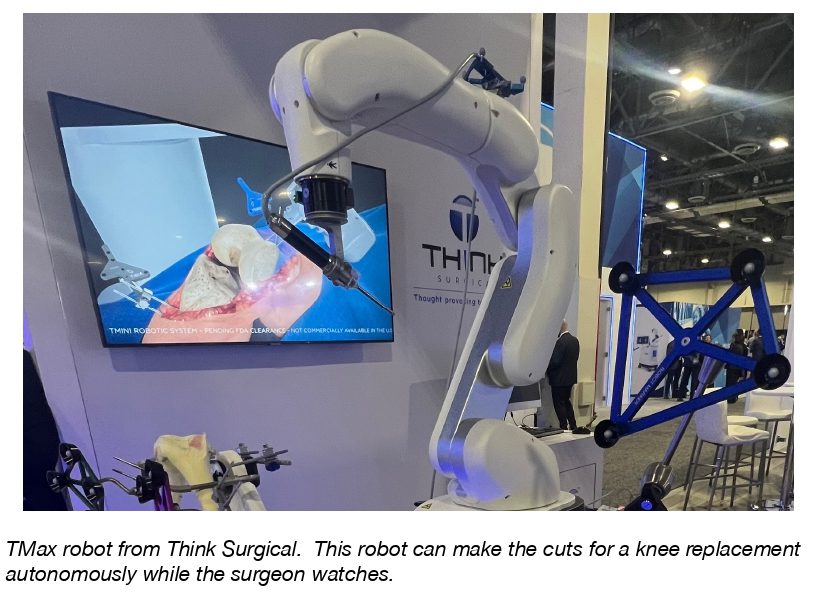
Shortly after the development of computer navigation, the first robot was used for a knee replacement. While the robot could offer more precision with the cuts, it was also slow and took up a significant amount of room in the operating room. Since that time, the technology has improved greatly. Now the computer navigation and robotics seem to work at real time speeds without the previous computer lag. The newer robotic systems are also smaller and take up less space in the operating room.
Today’s Joint Replacement Robots
The robots of today are much more user friendly to your surgeon. The speed of the computer navigation and robotics is beneficial to getting the surgery done in a timely fashion. This increase in speed translates into less anesthesia time, less bleeding, and lower infection risks than the computer and robotic technology of the 90’s. The surgical robots of today also have patient safety functions built into the system.
Currently, the three most commonly used systems in the United States are the MAKO by Stryker, the CORI by Smith and Nephew, and the ROSA by Zimmer Biomet. These systems offer joint replacement surgeons an excellent way to assist with implanting brand specific joint replacement components to achieve optimal joint alignment, range of motion, and stability. Always consult your orthopedic surgeon for his or her recommendation on the brand of implant and robotic system.
Most of the current joint replacement robotic systems use a Computed Tomography (CT) scan to combine multiple x-rays into a 3D image of the bones and joint. A computer program will use this 3D image for the computer navigation to reference during the surgery. The computer navigation uses reflective arrays attached to the patient by the surgeon to know where the bones are at all times. With this information, the robot can know precisely where the cuts need to be made when the sizes are templated using the computer. The computer navigation also can predict which cuts are the best to give the patient the most stable implant with the best motion before the cuts are ever made. To make the cuts, most of the robots guide the cutting instrument or hold a cutting guide in place.
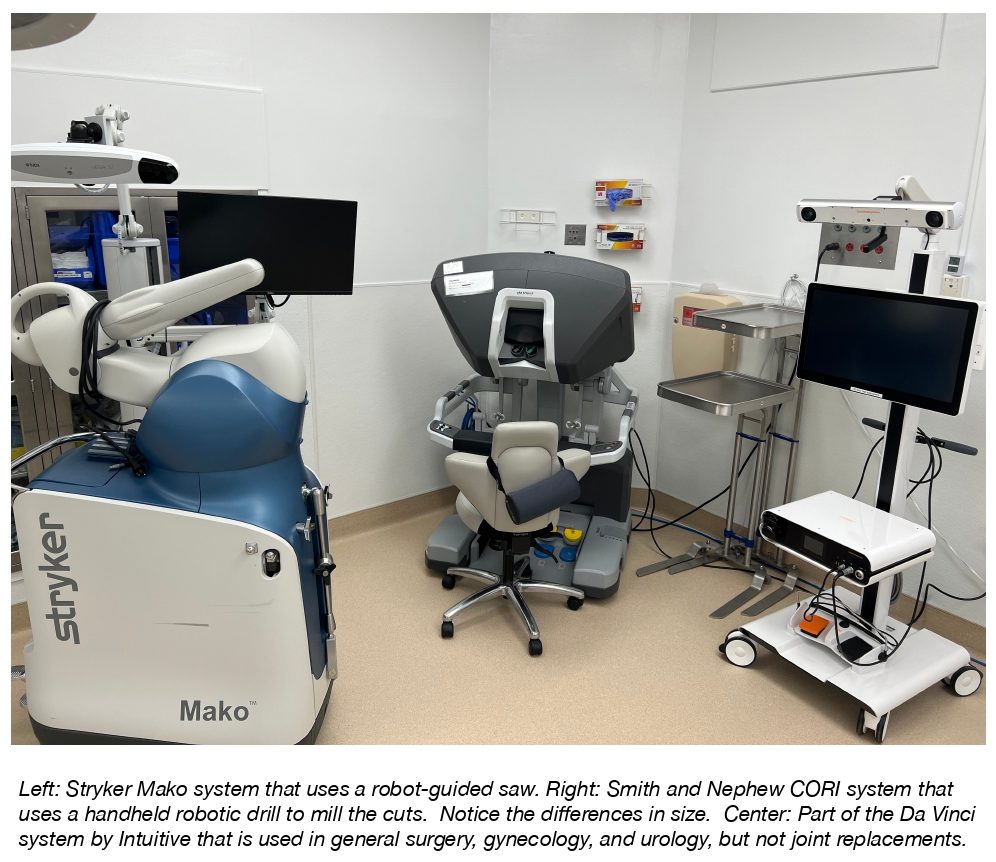
The technology is improving so fast that the size of the computers and robots is shrinking, thus freeing up space in the operating room. One of the systems is the CORI from Smith and Nephew. It does not need a CT scan, either. The surgeon simply paints the 3D image of the joint into the computer at the time of surgery. That same system has a small handheld robot for the surgeon to use to make the precise cuts. The smaller size of this system makes it ideal for use in surgery centers or small hospital operating rooms.
There is also a robot that makes the cuts for a knee replacement autonomously with the surgeon watching. It is the TMax from Think Surgical. While this robot is not FDA approved in the United States, it shows the direction the technology is headed. Soon, surgeons like myself, may be monitoring the robotic technology while no longer being an active part of making the cuts. Looks like my job could be in jeopardy!
For surgeons and patients that are concerned about outcomes, research studies are underway to determine the effectiveness of these technologies. In my opinion, the future looks bright for robots helping patients!
